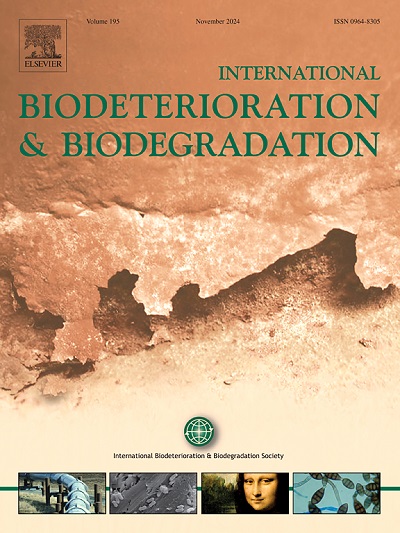Micro-Phyto-assisted reduction of Hexachlorocyclohexane (HCH) contamination in soil: A sustainable solution to mitigate HCH pollution
IF 4.1
2区 环境科学与生态学
Q2 BIOTECHNOLOGY & APPLIED MICROBIOLOGY
International Biodeterioration & Biodegradation
Pub Date : 2025-02-01
DOI:10.1016/j.ibiod.2024.105974
引用次数: 0
Abstract
This study pioneers a sustainable solution for Hexachlorocyclohexane (HCH) remediation through a unique microbe-assisted phytoremediation strategy, utilizing Ricinus communis inoculated with a novel yeast-bacteria rhizo-inoculum, Priestia megaterium and Meyerozyma caribbica. This combination achieved unprecedented reductions of its various isomeric residues viz. α-HCH (85.09%), β-HCH (91.80%), γ-HCH (95.24%), and δ-HCH (89.78%) over a 90-day pot experiment. R. communis demonstrated significant bioaccumulation of ΣHCH, primarily in its roots, followed by shoots and leaves. The HCH-exposed plants treated with mixed culture treatment exhibited a marked decrease in antioxidative defense enzyme activities: SOD (79%), APX (56%), GPX (68%), and CAT (55%) compared to control plants. Additionally, reduction of HCH residues in rhizospheric soil was significantly enhanced in the presence of microbial inoculum. Multivariate Principal Component Analysis (PCA) indicated significant differences in soil physico-chemical properties and plant enzymatic activities between treatments, closely linked to variations in HCH concentrations. PCA components accounted for 49.07% (PC1) and 15.02% (PC2) of the total variance in soil properties, and 65.66% (PC1) and 19.04% (PC2) in root enzymatic activities, with leaf enzymatic activities showing 69.70% (PC1) and 15.20% (PC2). These results suggest that inoculating R. communis with this novel yeast-bacteria mixed culture offers a highly effective and promising approach for the remediation of HCH-contaminated sites.

微植物辅助减少土壤中六氯环己烷污染:减轻六氯环己烷污染的可持续解决方案
本研究通过一种独特的微生物辅助植物修复策略,利用蓖麻接种一种新型的酵母菌根菌,巨型Priestia megaterium和加勒比Meyerozyma carbiica,开创了一种可持续的六氯环己烷(HCH)修复方案。在90天的盆栽试验中,该组合对其α-HCH(85.09%)、β-HCH(91.80%)、γ-HCH(95.24%)和δ-HCH(89.78%)的同分异构体残基进行了前所未有的还原。黄菖蒲对ΣHCH有显著的生物积累,主要在根,其次是茎和叶。与对照植株相比,混合培养处理的hch暴露植株的抗氧化防御酶活性显著降低:SOD(79%)、APX(56%)、GPX(68%)和CAT(55%)。此外,微生物接种显著增强了根际土壤中六氯环己烷残留量的减少。多变量主成分分析(PCA)表明,不同处理间土壤理化性质和植物酶活性存在显著差异,与HCH浓度变化密切相关。PCA分量占土壤性质总方差的49.07% (PC1)和15.02% (PC2),占根系酶活性总方差的65.66% (PC1)和19.04% (PC2),其中叶片酶活性占69.70% (PC1)和15.20% (PC2)。这些结果表明,用这种新型酵母-细菌混合培养物接种红豆杉为修复hch污染场地提供了一种非常有效和有前景的方法。
本文章由计算机程序翻译,如有差异,请以英文原文为准。
求助全文
约1分钟内获得全文
求助全文
来源期刊
CiteScore
9.60
自引率
10.40%
发文量
107
审稿时长
21 days
期刊介绍:
International Biodeterioration and Biodegradation publishes original research papers and reviews on the biological causes of deterioration or degradation.

 求助内容:
求助内容: 应助结果提醒方式:
应助结果提醒方式:


